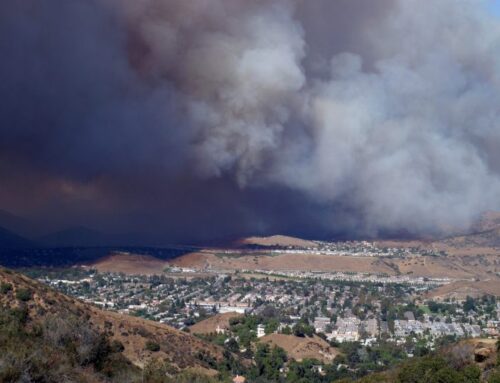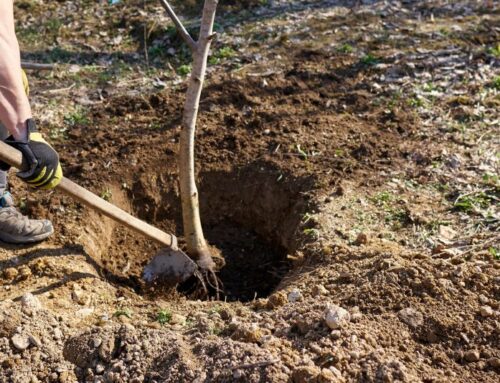Planting a tree is a gratifying experience that adds beauty, shade, and environmental benefits to your landscape. However, the success of your tree in the long run largely depends on how well you plant it, especially the proper depth of the planting hole. Planting a tree at the correct depth ensures its roots can access the right amount of soil, oxygen, and nutrients, setting it up for a healthy life. In this comprehensive guide, we will delve into the essential aspects of planting a tree at the correct depth. Read on to learn more!
How To Find a Root Flare and Why is It Important?
Before diving into the actual planting process, it’s vital to locate the root flare. The root flare, or root collar, is where the trunk transitions into the root system. It appears as a slight widening at the base of the trunk just above the topmost roots. This flare should be visible above the ground once the tree is planted.
Finding the root flare is crucial because planting a tree too deeply can lead to numerous problems, including excess moisture and limited oxygen in the root zone. Yes, roots need to breathe just like we do! People sometimes think trees only need carbon dioxide, and while this is true for the leaves, roots actually need oxygen. So, this lack of oxygen and excess moisture can lead to stunted root growth and an increased risk of root rot. So, gently brush away any excess soil or mulch around the tree’s base until the root flare becomes visible.
How Deep is Too Deep When Planting a Tree?
Planting a tree too deep is one of the most common plating mistakes and can have severe consequences for the tree’s health and longevity. When the root flare is buried beneath the soil, the tree’s ability to exchange gases with the environment is compromised. This lack of oxygen can cause the roots to suffocate, leading to poor growth, weakened structure, and increased susceptibility to diseases and pests.
Ideally, the top of the root flare should be at or slightly above the surrounding soil level. But be careful! Planting trees too shallow can also be detrimental, exposing the roots and making them susceptible to drying out.
Measure and Dig the Hole
Measuring and digging the hole correctly is crucial for establishing the right foundation for your tree. The hole should ideally be two to three times the width of the root ball, allowing the roots to spread and establish well in the soil.
The depth of the hole should be such that the top of the root ball or root flare is level with or slightly above the surrounding soil. To determine this depth, measure from the base of the root ball to the root flare. The hole should be no deeper than this measurement.
Installing The Tree
With the hole prepared, carefully place the tree in the center, ensuring the root flare or top of the root ball is at the desired planting depth. Adjust the positioning as needed to achieve the right height.
Backfill the hole with the soil you removed, ensuring it’s free of rocks, debris, and air pockets. Gently tamp down the soil to eliminate air pockets and provide stability to the tree. Water the tree thoroughly to settle the soil around the roots.

Watering Your New Tree
After planting, proper watering is vital to support the tree’s initial growth. Water the tree immediately after planting to help the soil settle and eliminate air gaps. Use a slow and deep watering method to ensure the water reaches the roots.
Monitor the soil moisture regularly, especially during the first year after planting. Trees need consistent moisture, but they don’t thrive in waterlogged conditions. Adjust your watering schedule based on weather conditions and the specific needs of the tree species. Here’s our general quick guide for watering newly planted trees.

Mulch
Applying a layer of organic mulch like wood chips around the tree’s base helps retain moisture, suppress weeds, and regulate soil temperature. Mulch also provides valuable nutrients as it decomposes. But don’t volcano mulch or pile mulch up against the tree trunk. Ensure the mulch is spread in a donut shape, leaving space around the trunk to prevent moisture accumulation and potential rot.

What to Do if The Tree Was Planted Too Deep?
If you suspect that your tree has been planted too deep, prompt action is essential. Carefully excavate the soil around the tree’s base to expose the root flare. Gradually remove excess soil until the root flare is visible. Try to avoid causing damage to the roots during this process.
After exposing the root flare, assess the depth and make necessary adjustments by adding or removing soil. Be cautious to maintain the correct planting depth to avoid further issues. If you discover decay or root rot in the excavation process, tree removal may be your safest option.
Not Sure How Deep to Plant Your Tree?
If you’re uncertain about the correct planting depth or have concerns about the health of your tree, you can always seek guidance from our team of professional arborists at A Plus Tree! Our certified and qualified arborists are experts in tree care and can assess your trees to provide customized recommendations. Check out our tree planting services to learn more!
So remember, planting a tree at the appropriate depth is critical for its growth and health. By finding the root flare, determining the right planting depth, and following proper planting and care techniques, you can ensure your tree thrives and contributes to the beauty of your landscape for years to come. If in doubt, consult a professional arborist to ensure your tree is off to a healthy start. Happy planting!





